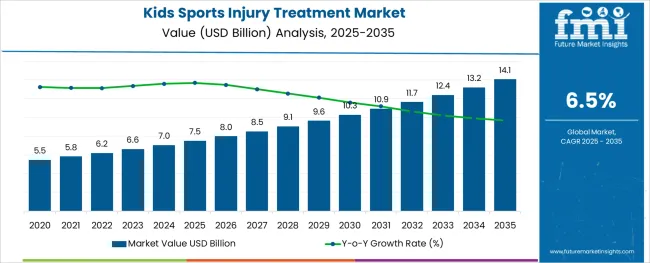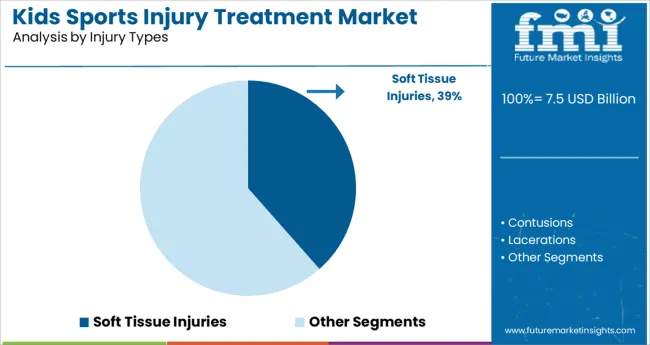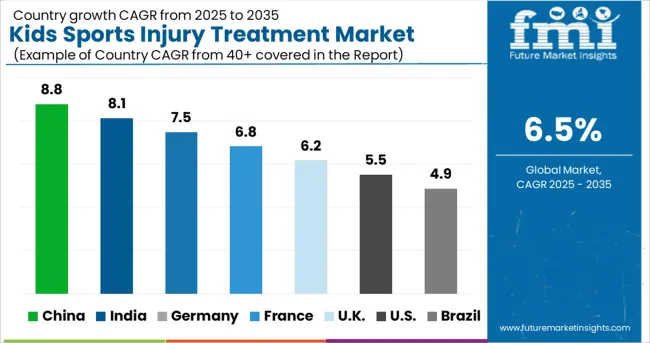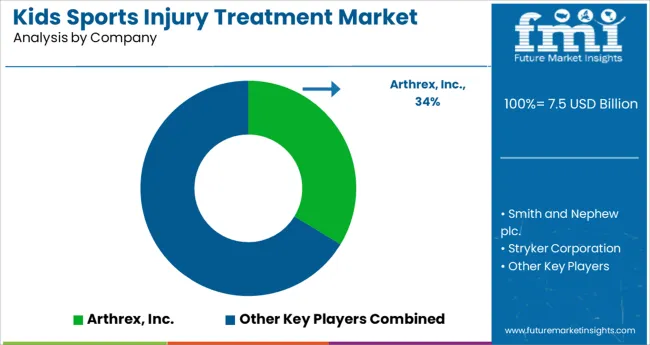The Kids Sports Injury Treatment Market is estimated to be valued at USD 7.5 billion in 2025 and is projected to reach USD 14.1 billion by 2035, registering a compound annual growth rate (CAGR) of 6.5% over the forecast period.

The kids sports injury treatment market is witnessing steady growth driven by increasing participation of children in organized and recreational sports activities and a corresponding rise in injury incidence. Heightened awareness among parents, coaches, and pediatricians about early diagnosis and effective management of sports injuries is contributing to market expansion.
Pediatric healthcare systems are increasingly prioritizing dedicated treatment protocols tailored for children, considering their developmental physiology and long term musculoskeletal health. Advancements in minimally invasive treatment methods, physical therapy solutions, and wearable rehabilitation technologies are improving recovery outcomes and reducing recurrence risks.
Support from schools and sports academies to ensure regular injury screening and follow up care is also supporting market growth. With rising emphasis on child wellness and safe athletic participation, the market outlook remains positive as healthcare providers and caregivers continue to invest in timely and customized injury management solutions.
The market is segmented by Injury Types and region. By Injury Types, the market is divided into Soft Tissue Injuries, Contusions, Lacerations, Sprains, Strains, Overuse Injuries, Rotator Cuff Tendonitis, Thrower’s Shoulder and Thrower’s Elbow, Osgood Schlatter Disease, Sinding-Larsen-Johansson Syndrome, Sever’s Disease, and Osteochondritis Dissecans. Regionally, the market is classified into North America, Latin America, Western Europe, Eastern Europe, Balkan & Baltic Countries, Russia & Belarus, Central Asia, East Asia, South Asia & Pacific, and the Middle East & Africa.

The soft tissue injuries segment is expected to account for 38.50% of total market revenue by 2025 within the injury type category, positioning it as the dominant segment. This is primarily due to the high occurrence of strains, sprains, and contusions among children involved in sports activities.
The active and often repetitive nature of sports increases the likelihood of soft tissue trauma, especially in fast paced and contact sports. These injuries typically require conservative yet effective treatments such as rest, physiotherapy, compression therapy, and activity modification which are widely accessible and child friendly.
Pediatric orthopedic and physiotherapy units are increasingly equipped to address soft tissue injuries through non surgical and evidence based approaches that ensure long term joint and muscle health. The relatively quicker recovery period, lower complication risks, and prevalence of these injury types have collectively made soft tissue injuries the most frequently treated category in the kids sports injury treatment market.
Over the past several years, sports injuries have become more common across the world, mostly because more kids are participating in sports and actively engaging in fitness activities (as a result of the growing focus on leading healthy lifestyles). Around 30 million kids and teenagers in the USA participate in sports each year, and more than 3.5 million sports injuries are documented, according to Stanford Children's Health.
In the US, there are around 2 million acute ankle injuries each year, according to the Board of Certification for Athletic Trainers. Children who participate in sports frequently sustain ligament rips and fractures. Furthermore, a significant percentage of sports injuries worldwide involve the lower extremities. During the evaluation period, the market is projected to grow due to the increasing frequency of ligament tears and fractures. As a result, it is anticipated that the sector is anticipated to grow globally due to the rising need for injury treatment and rehabilitation.
Kids sports injury treatment is becoming more prevalent in emerging economies, which presents a significant opportunity for the market's expansion. Due to their vast patient populations, developing nations like China and India are projected to present a sizable opportunity for market development. Due to increased disposable income and expanding kid and adult engagement in sports, the market for kids sports injury treatment is anticipated to expand.
Lack of sports culture likely to be a major obstacle to market expansion
The primary factor for the growth of global kids’ sports injury market is growing accidents during practice or during performance as the number of children participants in sport activities increases every year from all the age groups. Adequate sports training programs are conducted through private trainers and sport clubs to reduce the accident rate while training so that associated risks are minimized during performances or competitions.
Main factor that restrain the global kids sports injury treatment market is increasing awareness of the parents, providing modified training programs and using safety tools, equipment or safety apparels for the children while practicing.
According to the data from the United State Consumer Product Safety Commission’s National Electronic Injury Surveillance System of 100 hospital emergency departments, most of patients that are injured between the age of five and 16 years are injures while playing or practicing basketball, football, baseball, ice hockey, soccer or softball. A kid should get first-aid attention immediately for acute injuries. A visit to a pediatrician is essential even if the injury appears normal and proper diagnosis is necessary for quick healing.

The global kids’ sports injury treatmentmarket is expected to register a healthy CAGR during the forecast period. Depending on geographic region, global kids’ sports injury treatment market is segmented into seven key regions: North America, South America, Eastern Europe, Western Europe, Asia Pacific, Japan, and Middle East & Africa.
North America held largest share in the global market of kids’ sports injury treatment market followed by Europe, Japan and APAC owing to increase in the number of accidents while playing and developed healthcare infrastructure. The developing nations in APAC, MEA hold huge potential for growth in the global kids’ sports injury treatment market, due to the awareness and concern in the parents in regards to their children.

Some of the key participating global players in kids’ sports injury treatment markets are Stop Sports Injuries, Arthrex, Inc., Smith and Nephew plc. Stryker Corporation, Zimmer Biomet Holdings Inc.
The research report presents a comprehensive assessment of the market and contains thoughtful insights, facts, historical data, and statistically supported and industry-validated market data. It also contains projections using a suitable set of assumptions and methodologies. The research report provides analysis and information according to categories such as market segments, geographies, types, technology and applications.
The report is a compilation of first-hand information, qualitative and quantitative assessment by industry analysts, inputs from industry experts and industry participants across the value chain. The report provides in-depth analysis of parent market trends, macro-economic indicators and governing factors along with market attractiveness as per segments. The report also maps the qualitative impact of various market factors on market segments and geographies.
The global kids sports injury treatment market is estimated to be valued at USD 7.5 billion in 2025.
It is projected to reach USD 14.1 billion by 2035.
The market is expected to grow at a 6.5% CAGR between 2025 and 2035.
The key product types are soft tissue injuries, contusions, lacerations, sprains, strains, overuse injuries, rotator cuff tendonitis, thrower’s shoulder and thrower’s elbow, osgood schlatter disease, sinding-larsen-johansson syndrome, sever’s disease and osteochondritis dissecans.
segment is expected to dominate with a 0.0% industry share in 2025.






Our Research Products

The "Full Research Suite" delivers actionable market intel, deep dives on markets or technologies, so clients act faster, cut risk, and unlock growth.

The Leaderboard benchmarks and ranks top vendors, classifying them as Established Leaders, Leading Challengers, or Disruptors & Challengers.

Locates where complements amplify value and substitutes erode it, forecasting net impact by horizon

We deliver granular, decision-grade intel: market sizing, 5-year forecasts, pricing, adoption, usage, revenue, and operational KPIs—plus competitor tracking, regulation, and value chains—across 60 countries broadly.

Spot the shifts before they hit your P&L. We track inflection points, adoption curves, pricing moves, and ecosystem plays to show where demand is heading, why it is changing, and what to do next across high-growth markets and disruptive tech

Real-time reads of user behavior. We track shifting priorities, perceptions of today’s and next-gen services, and provider experience, then pace how fast tech moves from trial to adoption, blending buyer, consumer, and channel inputs with social signals (#WhySwitch, #UX).

Partner with our analyst team to build a custom report designed around your business priorities. From analysing market trends to assessing competitors or crafting bespoke datasets, we tailor insights to your needs.
Supplier Intelligence
Discovery & Profiling
Capacity & Footprint
Performance & Risk
Compliance & Governance
Commercial Readiness
Who Supplies Whom
Scorecards & Shortlists
Playbooks & Docs
Category Intelligence
Definition & Scope
Demand & Use Cases
Cost Drivers
Market Structure
Supply Chain Map
Trade & Policy
Operating Norms
Deliverables
Buyer Intelligence
Account Basics
Spend & Scope
Procurement Model
Vendor Requirements
Terms & Policies
Entry Strategy
Pain Points & Triggers
Outputs
Pricing Analysis
Benchmarks
Trends
Should-Cost
Indexation
Landed Cost
Commercial Terms
Deliverables
Brand Analysis
Positioning & Value Prop
Share & Presence
Customer Evidence
Go-to-Market
Digital & Reputation
Compliance & Trust
KPIs & Gaps
Outputs
Full Research Suite comprises of:
Market outlook & trends analysis
Interviews & case studies
Strategic recommendations
Vendor profiles & capabilities analysis
5-year forecasts
8 regions and 60+ country-level data splits
Market segment data splits
12 months of continuous data updates
DELIVERED AS:
PDF EXCEL ONLINE
Winter Sports Injury Treatment Market Size and Share Forecast Outlook 2025 to 2035
Kids Sports Equipment and Accessories Market Size and Share Forecast Outlook 2025 to 2035
White Matter Injury Treatment Market Size and Share Forecast Outlook 2025 to 2035
Acute Kidney Injury Treatment Market Growth - Trends & Forecast 2025 to 2035
Cutaneous Radiation Injury Treatment Market
Ischemia Reperfusion Injury Treatment Market Size and Share Forecast Outlook 2025 to 2035
Sports Medicine Sutures Market Size and Share Forecast Outlook 2025 to 2035
Kids Splint Market Size and Share Forecast Outlook 2025 to 2035
Sports Betting Market Size and Share Forecast Outlook 2025 to 2035
Sports Wearables Market Size and Share Forecast Outlook 2025 to 2035
Kids Toys Market Size and Share Forecast Outlook 2025 to 2035
Sports Protective Equipment Market Size and Share Forecast Outlook 2025 to 2035
Sports Sunglasses Market Size and Share Forecast Outlook 2025 to 2035
Treatment-Resistant Hypertension Management Market Size and Share Forecast Outlook 2025 to 2035
Sports Turf Seed Market Size and Share Forecast Outlook 2025 to 2035
Kids Shampoo Market Size and Share Forecast Outlook 2025 to 2035
Sports Nutrition Ingredients Market Size and Share Forecast Outlook 2025 to 2035
Sports Food Market Size and Share Forecast Outlook 2025 to 2035
Sports Bicycles Market Size and Share Forecast Outlook 2025 to 2035
Treatment-Resistant Depression Treatment Market Size and Share Forecast Outlook 2025 to 2035

Thank you!
You will receive an email from our Business Development Manager. Please be sure to check your SPAM/JUNK folder too.
Chat With
MaRIA